|
Exercito Brasileiro Army of Brazil D.F Vasconcellos Industria Brasileira Pioneiro 6x30 Military Binoculars made in Brazil |
|
As WWII mobilization contracts preempted the exportation and supply of military optics from traditional suppliers like Germany, the UK, and the USA (for the second time in 40 years), other countries viewed developing a domestic military optics industry as being in the nation’s strategic interest (Just as Japan had done immediately after WWI). D.F. Vasconcellos Industria Brasiliera was founded in Sao Paulo Brazil in April 1941, and it’s first decade was devoted exclusively to producing military optics, such as my 6x30 Brazilian Army marked binoculars in it’s DFV and Exercito Braziliero marked case. After 1951 D.F. Vasconcellos added civilian optics, and then in 1962 they branched into surgical microscopes, and now they specialize in microsurgery optical instrumentation. The “ A ” and flaming bomb presumably indicates ordnance (artillery) division intended usage. |

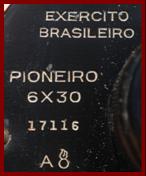
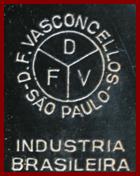


|
Czech Optikotechna P ŕ erov 8x30 Military Binoculars with Reticule |
|
My 8x30 military binoculars carry the OP logo of Optikotechna P ŕ erov. Since this firm was nationalized in 1946, and according to a 2010 Meopta presentation was renamed Meopta in 1946, I believe these binoculars must predate 1943. I believe 670 was their model number for 8x30 binoculars with reticule/ ranging grid. Optikotechna P ŕ erov was founded in 1933, and then became a subsidiary of Zbrojovka Brno in 1935, and was a major supplier to the Czech army and a supplier to other armies (including Sweden) After 1939 the company produced only military optics, including binoculars, ZF4 rifle scopes, periscopes, & range finders. It was then under German control during the occupation of Czechoslovakia, so WWII Optikotechna binoculars produced after 1943 under the German occupation would have carried only the d.o.w. German wartime manufacturer code. |
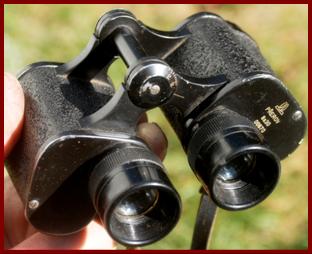
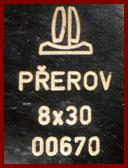

|
“OP” logo |

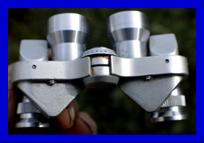
|
Japanese External Reverse Porro Prism Binoculars. WEBSITE MUSEUM |
|
OTHER BINOCULARS #9 & OPTICAL SIGHTS (MOSTLY MILITARY) |
|
Ex é rcito Brasileiro Army of Brazil Czech made Optikotechna P ŕ erov 8x30 Military Binoculars made in Czechoslovakia. |
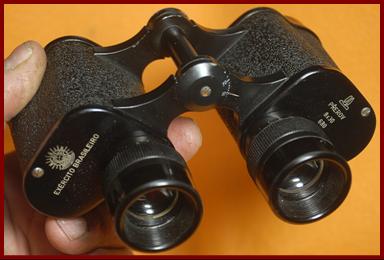


|
My 8x30 Brazilian Army / Ex ér cito Brasileiro military binoculars carry the OP logo of the Czech optical firm Optikotechna P ŕ erov. Since this firm was nationalized in 1946, and also according to a 2010 Meopta presentation it was renamed Meopta in 1946, I believe these binoculars must predate 1943. I believe that 680 is their model number for 8x30 binoculars without reticule/ ranging grid. More information on Optikotechna P ŕ evov binoculars appears with the binoculars below. |
|
1927 Polish H. Kolberg iSka 6x30 WP (Wojsko Polskie/Polish Army) Military Binoculars w/ graticule |
|
Fabryka Aparatur Optycznych I Precyzyinch H. Kolberg iSka S.A. (Factory of Optical & Precise Instruments H. Kolberg Ltd) was established in Poland in 1921, and my 6x30 binoculars were part of a 1925 4,000 polish military 6x30 binoculars contract which funded manufacturing equipment purchases to establish the factory. My 6x30 binoculars carry the WP Wojsko Polskie/ Polish Army mark, plus Polish eagle, and by serial number #10667 they were produced in 1927. Info credit “The History of 6x30 binoculars H. Kolberg iSka and PZO” by Anna Vacani. |
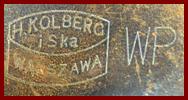
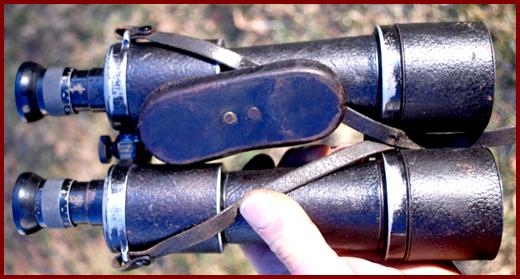
|
Strange and Unusual ! Carl Zeiss Jena Binoct ?? Perhaps Marketing sample 7x50 binoculars |
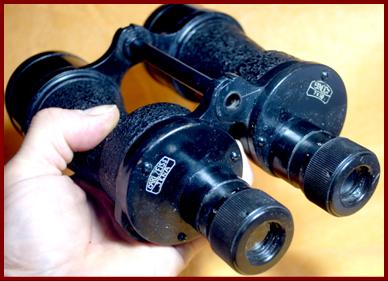
|
When I encounter a product that appears factory produced but whose configuration & markings are inconsistent with known production, I think marketing prototype. The reason that I think this is that as a former product engineer, product line director, marketing director, marketing VP, and sales rep at 4 companies I probably had 100 examples of non standard product (prototypes and mockups ) made for me with non standard designs, colors, features, markings, logos, and also had existing products re-branded: and their purpose was to measure distributor/market demand at trade shows; as samples for potential contracts; for field trials; as sales samples, etc.: of items which did and did not proceed to production. And I probably watched colleagues have 1,000 prototypes made. Real example: I had a meeting with the head of the NY state prison system with a prototype, and then ran a successful field trial of 2 functional prototype body orifice contraband metal detecting chairs as proposed prison equipment at two New York state prisons. And then New York, Ct., and other state and federal prison systems purchased them for their maximum and medium security prisons. I still have those two prototypes. If someone looked at them they might say “the co. never made them that way”, because those two trial prototypes differed in ways to the production models. They were factory made, factory marked, functional, but not standard production: only field trial prototypes. For every product ever manufactured, various prototypes were made, plus prototypes and mockups were also made for millions of products being considered for marketing/production or applying for patents. Most are destroyed as useless, but some just get taken home, like I sometimes did. When I had prototypes made, they did not normally get a serial number because they were not part of a production, except when mandated by law (firearms), which like military contract guns would get a different serial number from regular production. I have a collection of prototypes including stuff I wasn’t involved in, including one of the world’s larger collection of factory made salesman sample cut away padlocks and locks. My point is that for me Zeiss markings and a seemingly unknown Zeiss product name (“Binoct”) on Ross or NIL No 4 or No 5 pattern binoculars (a Steplux variation), with no serial number (both Zeiss and Ross/NIL always had serial numbers) and with no sign of ever having had any other markings, to me suggests being a prototype made at some factory. I know that when WWII ended Ross was desperate to find sales markets, but the only country whose consumers had lots of disposable income and big demand for binoculars was the USA. But there was no consumer market demand in the USA for Ross brand binoculars. But the US government had widely advertised during the war that they needed Zeiss binoculars to be donated to the US military, and they were one of the most desired soldier bring back items, so everybody knew Zeiss binoculars were desirable. The idea of Carl Zeiss Inc (independent US importer) or another importer/distributor exploring the feasibility of Zeiss branded Ross/NIL binoculars for the wealthy and binoculars hungry post war US market seems a logical probability to me, but it is just educated conjecture. |

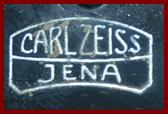
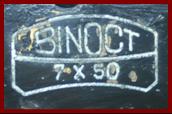
|
Zeiss marked binoculars are on the left side. Naval pattern (added red naval desiccation ports) Ross No 5 Mk 4 binoculars are on the right. |

|
In support of my speculation (these being a Zeiss branded Ross factory made importer sample and not an end user fake) and contrary to what one might suppose, in the immediate post war period neither of the two surviving Zeiss named entities (in East & West Germany and with both making Zeiss logo marked binoculars) apparently had any trademark rights to Zeiss name/ Zeiss logo use on binoculars. The West German Zeiss entity apparently obtained a West German trademark 641728 registered June 20 1953 for West Germany. The West German Zeiss entity applied for a US trademark (for “Carl Zeiss” plus rectangle or segmented rectangle with one or more curved sides) Dec 10,1953 in the USA (but did not make any claim of any priority date activity in US commerce for prior to 12/10/53), and it appears their trademark registration was not granted until Oct. 5 1971/ #0921537. The West German Zeiss entity obtained a “Carl Zeiss Jena” logo design as a UK trademark registered May 20,1971/#975176). So I believe non Zeiss affiliated entities had a legal right to have manufactured/imported/marketed a Zeiss logo but non Zeiss associated binocular, as my Carl Zeiss Ross binoculars may be a sample of, in the US prior to 1953, and probably in the US and the UK up to 1971. There is evidence that various importers had non Zeiss manufactured binoculars made that looked as much like Zeiss models as possible, and with Zeiss logos and with standard Zeiss model names on them, and these were certainly intended to deceive customers. And apparently Zeiss at one point had binoculars contract made in Japan, widely proclaimed as being fake Zeiss binoculars, until evidence apparently surfaced that they were actually contracted for by Zeiss. |
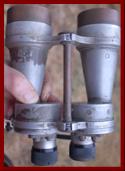

|
NIL Nottingham Ind Ltd naval binoculars |
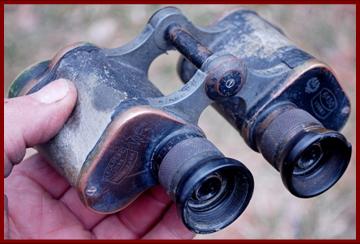
|
Barr and Stroud Royal Navy binoculars attributed to battleship HMS Queen Elizabeth in WWII |

|
The battleship HMS Queen Elizabeth was launched in 1913, upgraded for WWII, was damaged in Alexandria Egypt on Dec. 1941 by Italian frogmen Antonio Maceglia and Spartaco Schergat of the manned torpedo Siluro Lenta Corsa 222 of the X Flottiglia MAS. HMS Queen Elizabeth returned to service in June 1943. It’s presence in Egypt was related to protection of the Suez canal shipping activity. |
|
People have an inherent affinity for badges of shared association (“assertion I was there”): think of world fair pins, or wanderstock stocknagel walking stick place badges, or military campaign ribbons, or soldier painted names of battles on their helmets. When I see ship + place + date on binoculars I perceive it as participant commemoration and/or sometimes a presentation item given by comrades at end of naval service. |
|
Jules Huet & Cie 16x40 British Military marked binoculars documented first sold in Argentina |
|
My Jules Huet & Cie. 16x40 binoculars are marked as originally having been sold at retail by the optical shop G. Catton Optico , 531 C .(Calle) Pellegrini, Buenos Aires (Argentina). (This firm is documented as a seller of optical goods in the 1914 United States Bureau of Foreign & Domestic Commerce Directory). These binoculars are also British War Office broad arrow property marked, This is not actually an ownership contradiction, as in WWI and WWII in order to meet military binoculars shortages, the UK widely solicited donation of decent civilian binoculars, which if accepted into military service, would have received government property markings such as these. |
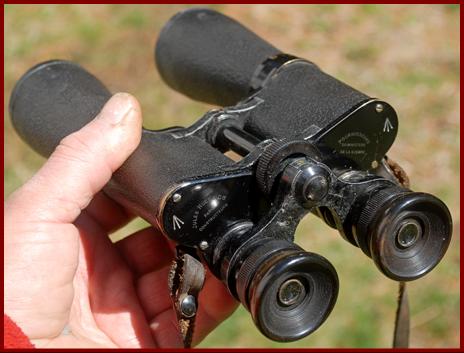
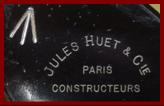
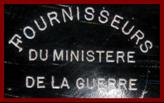


|
“Suppliers to the ministry of war” logo. |
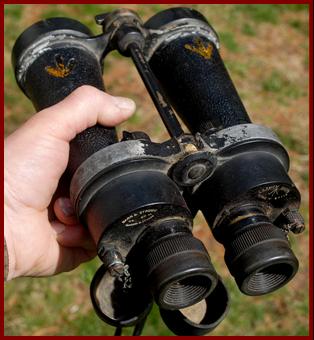
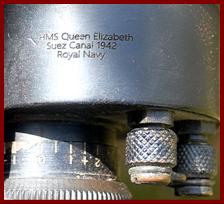
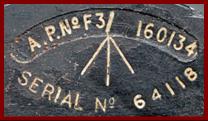
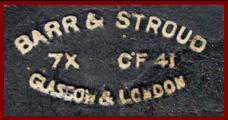

|
These binoculars have typical Royal Naval features such as rotating filter system, dessicant ports, and the painted over large yellow broad arrow typical of British naval released from UK naval service. |
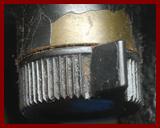
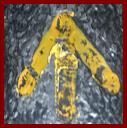
|
1944 WWII Indian army No. 2 Mk. II x6 binoculars made by IndianOrdnance Factory in Calcutta |
|
North Korean 8x30 army KPA/ Korean Peoples Army 8x30 binoculars made in North Korea DPRK/ Democratic Peoples Republic of Korea |
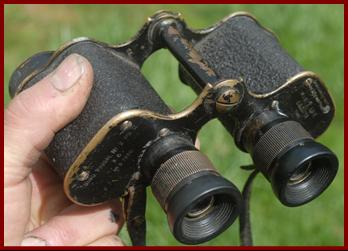


|
It is my understanding that the Mathematical Instrument Office ( M.I.O. ) established the Indian Ordnance Factory ( I.O.F ) in Calcutta India in 1941 to produce Artillery directors, binoculars, and prismatic compasses. And from April 1941-August 1945 the I.O.F. `produced 17,724 No 2 6x30 binoculars, including my 1944 example. The broad arrow over “ I ” is the Indian government property mark. (Information credits Frank Flagorio, William Reid). The S arrow S is not proven, but is plausibly an Indian Signals Squadron marking (speculative). |
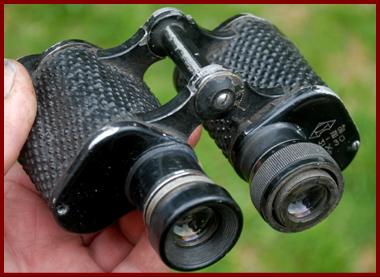

|
The Google Translate Ap on my phone interprets this as “Chosun Pyongyang” under the factory logo. Additional info sought? Miniature.binoculars@ gmail.com. |
|
It impressed me that my North Korean KPA/ Korean Peoples Army 8x30 binoculars were obviously designed for easy field servicing: they were probably one of the easiest to disassemble and work on of any full size binoculars I have encountered. (I had to clean and recollimate mine). I believe my binoculars post date the Korean war/ post 1953. I have found little public information on North Korean optical industries, and would welcome further insights that viewers might be able to provide to miniature.binoculars@gmail.com. |
|
U.S. Army WWII marked Wollensak (M5) 6x30 binoculars issued as Australian Army property marked No2 Mk 11 binoculars and marked R.L.B. |
|
My WWII US Army marked Wollensak 6x30 R.L.B. binoculars also marked as UK/ Commonwealth (type) No2 Mk II and with Australian military Broad Arrow/ D property markings presumably represent a US Army contract diverted to Australia. In May 1941 the US military contracted for 16,000 Wollensak 6x30 binoculars with U.S. property markings. But the March 1941 Lend Lease agreement had authorized transfer of US military equipment to the UK and Commonwealth. So in July 1941 58,000 Wollensak binoculars were then requisitioned for the UK/Commonwealth under Lend Lease. My Wollensak 6x30 U.S. marked and R.L.B. marked serial no. 2018 binoculars were part of those transferred by the U.S. to Australia, and were type re-designated as No 2MKII and Australian D D property marked, and painted green for the Jan. 1943 Papua New Guinea campaign. (A quantity of U.S. Army marked and Australian and New Zealand marked Wollensak binoculars in black and green are known and documented, with R.L.B and F.J.A. inspection authorization). The earlier R.L.B. inspection mark is inspection under authority of U.S. Col. Ray L. Bowlen. Reference acknowledgement: Robin Leaech: Wollensak History-Binoculars & Optics |


|
1934 Australian army Ordnance Services standing orders on property marks on Australian military equipment, of Defense department equipment property (D arrow D) and also of property obtained under the High Commissioner’s Office (arrow within D). |
|
(first example) Establts AFSA Serie 6 French Military binoculars MG/ Minist č re de la Guerre marked, but that are also UK military broad Arrow property Marked. |
|
W.S.L.D.V. West Sussex Local Defence Volunteers marked Magnus 12x30 binoculars marked to commander Leslie Evershed-Martin of #5 company C platoon 1st battalion/Chichester Home Guard |
|
The Chichester Home Guard was formed in the summer of 1940 as part of the West Sussex (UK)Local Defense Volunteers to counter a threatened German invasion, and emplaced 2 howitzers aimed at Thorney Island. My Magnus 12x30 private purchase binoculars and case are marked W.S.L.D.V. for W est S ussex D efense V olunteers and are engraved EVERSHED-MARTIN CHICHESTER for Leslie Evershed Martin (OBE, CBE), commander of 5 company C platoon 1st Batalion W.S.L.D.V. /Chichester Home Guard. Leslie Evershed Martin went on to become mayor of Chichester and founded the Chichester Festival Theater. Credit: A to Z Chichester by Phillip MacDougall |
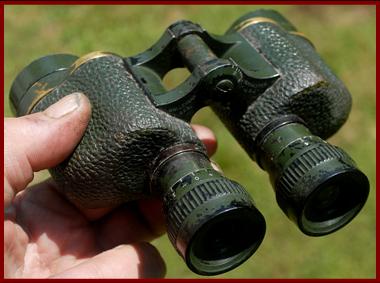





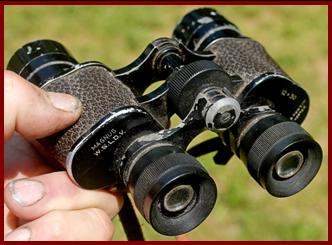


|
AFSA was a supplier of French military equipment including binoculars circa WWI, and documentation does exist that AFSA binoculars were also sold to the US and UK military in WWI (the US military/ Franford Arsenal disposed of 2,754 pairs of Afsa binoculars as military surplus in 1921). My Establissments Afsa serie 6 binoculars carry the MG French Minist č re de la Guerre property mark, and they also carry the British Broad Arrow property mark. The UK military did property mark and issue both contracted and used non standard binoculars they acquired as property, including those acquired by private donation in WWII, and to some degree in WWI, as substitute standard due to the shortage of standard binoculars. And also during both wars, some contracted property marked military binoculars were diverted among allies, if surplus to issue, and/ or in exchange for more valued armaments. An attempt has been made to scratch out the serial identity S.2 2102, typical on absconded military equipment. The case is broad arrow marked and is also subsequent owner named. |

|
1912 Annuaire Officiel des Officers de l’arme é active |


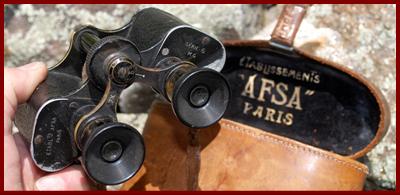




|
WWII Crown Optical Co. (Queen Mary troopship ??) 6x30 British Military Broad Arrow Property Marked binoculars |
|
Here is what is documented. The Crown Optical Co. of Rochester NY had WWI British military contracts for binoculars including #B750-579W of 7/15/16 ($350,000) and B1264-1015W of 5/14/17 ($350,000). Those binoculars have the Crown Optical markings plus broad arrow British military property marks, including my 6x30 example, serial number 9518, documented in Other Binoculars #6. The Crown Optical Co. was commandeered in Dec 1917 by the US government and turned into part of the US Naval Gun factory, and Crown Optical thereafter ceased to exist. (My other pair also have the same superimposed opposing broad arrow military disposal mark). These binoculars have two serial? Numbers: S2 36676 and 24960 Now to some speculation… These binoculars have what I believe is a “ Q ” (anchor) ” M ”, and what appears to be a very large identity number of “ No. 88 ”.They have UK broad arrow military property & disposal markings. I believe these might be binocular No.88 of the very large quantity of binoculars RMS Queen Elizabeth utilized when she was heavily used as a troop transport during WWII. They were not sold to me as being such, and I emphasize that this is just a speculative hypothesis on my part. It is documented that after the Queen Mary ocean liner was converted into a troop transport at Cockatoo Docks in Sydney Australia in March 1940, and on her many subsequent troop transport voyages carrying as many as 16,683 troops on each voyage, that the Queen Mary usually had 863 to 943 crew members. It is documented that the ship was very concerned about being torpedoed, or sea mined, and that she deployed very large squads of lookouts, probably around the clock; and she presumably had them posted all around the ship looking for torpedo wakes; and she presumably had them looking with binoculars. (And it is documented that this concern was fully justified, because Hitler offered the large motivation of a $250,000 equivalent cash prize plus iron cross medal with oak leaves honor to any of his submarine captains that could sunk the Queen Mary troopship). Both the UK and US military were acutely aware of the potential of huge life loss and of huge loss of face/morale that a Queen Mary loaded troopship sinking would bring, and they actually studied the Titanic sinking in that regard. (In WWII submarines tended to linger to torpedo rescue ships, so larger ships usually did not stop to help sinking ships/ survivors). So Queen Mary can be reasonably assumed to have had a lot of binoculars for auxiliary lookouts searching for any signs of submarine threat. And then after the Queen Mary’s 1942 anti aircraft capability refit, to counter air attack, the Queen Mary then had twenty nine 44mm anti aircraft gun positions, plus two anti aircraft rocket launcher positions, plus six 3” gun positions. Presumably every shift of every gun crew for each of these 37 gun positions would have had an aircraft spotter with binoculars. Managing such a large quantity of binoculars would have necessitated a critical need to keep track of exactly which binoculars were in service; exactly which binoculars were being repaired or were out of service; and which were held in reserve stores; and which binoculars had been issued to who. This does fit logically having such a very large “ No.88 ” identification stores type mark: something I have not seen on military or naval binoculars before. Binoculars in naval service (any nationality of Navy) do not normally have any functional reason to have a ship name marking or identity for in service use. But every soldier being transported on the Queen Mary would have been happy to scoop up any unidentifiable binoculars for their own use, so a property identification that would red flag missing binoculars as stolen does make sense as basic loss deterrence. Most navy ships used quite small quantities of normally fairly specialized naval binoculars: usually a higher power than 6 for longer distance spotting; and usually with larger objectives for critical maximum light transmission; and in UK Naval service they were normally fitted with colored filters and desiccating ports. But if you are fielding really large quantities of binoculars for non specialized defensive observation tasks such as looking for torpedo wakes or for airplanes, then standard infantry binoculars like these Crown Optical Co. binoculars may have been seen as being good enough, and particularly if far more available and/or readily available from reserve stocks of non standard military binoculars, with officers and the mast lookouts probably having the better more specialized and more scarce naval binoculars. (speculative). Plus with a crew of nearly 1,000, the Queen Mary would certainly have had the authority to requisition a couple of crew members with binocular repair skills, and plenty of room to set up a workshop. All speculative? Sure. Documented? Not at all. Provable? Presumably nobody with first hand knowledge is still alive, and unless there is somebody out there where a WWII era Queen Mary ancestral crew member who discussed having made off with binoculars, probably not. Plausible? I do think that this hypothesis is plausible, and regardless of the exact probability, I do think that it is an entertaining and fun idea to explore for UK military binoculars with odd and naval oriented markings ! (By the way, I did find evidence that the liner Queen Mary did use Q.M. markings as a property mark on items). |

|
Example of a “Q.M.” property marking on another item that is well documented as having been from the RMS Queen Mary ocean liner, in this case a table, and evidence that the RMS Queen Mary did use “Q.M.” in the role of a utility property mark on shipboard items. |


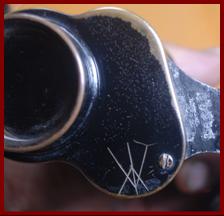

|
North Korean manufactured North Vietnamese Army Quân đội Bắc Việt 8x30 military binoculars |
|
I believe that my 8x30 binoculars marked in Korean as “binoculars’ (model?) “73” are an example of North Korean manufactured binoculars supplied to NVA/ North Vietnamese Army troops ( Quân đội Bắc Việt ) during the North/South Vietnam/ US conflict. |
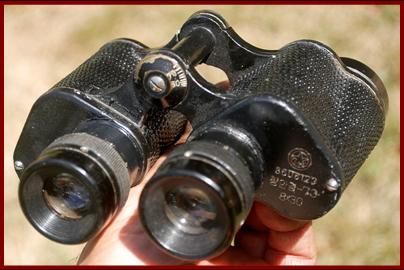
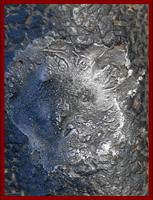

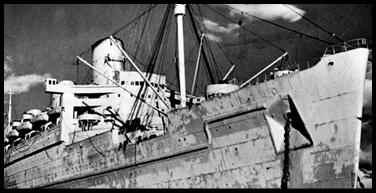
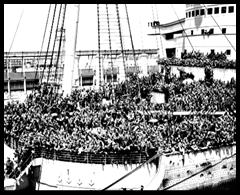
|
FOR GERMAN WWII BINOCULAR and OPTICAL MANUFACTURER CODES |

|
Falklands/ Malvinas War Era Meopta Czechoslovakia made 6x30 Ejercito Argentino / Argentine Army Anteojo Binocular/ telescopic binoculars |
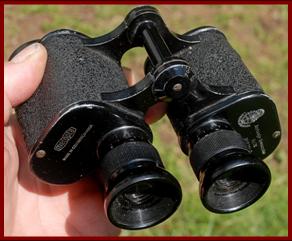


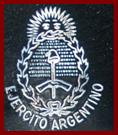
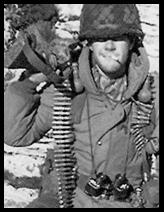
|
Argentine Soldier in Falklands with binoculars |
|
My Ejercito Argentino/ Argentine Army 6x30 military binoculars were made by the Meopta firm in Czechoslovakia under contract to the Argentine military. These type binoculars are known to have been in active service during the Falklands/ Malvinas Islands conflict of 1982 |
|
1944 U.S. Navy UniversalCamera Corp. BU Ships Mark 33 Mod. 1 6x30 Military Binoculars |
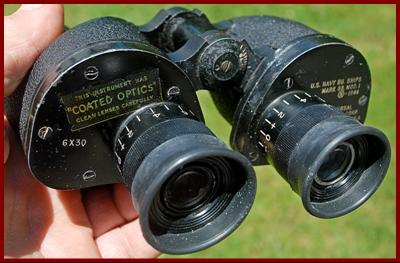
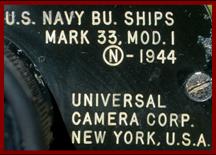

|
My U.S. Navy Mark 33 Mod. 1 6x30 binoculars were produced in 1944 by the Universal Camera Corp. of New York City by authority of the U.S. Navy Bureau of ships, created on June 20,1940, in effect consolidating many aspects of design and procurement under the new organization. Universal Camera Corp. was founded in 1932 and produced 37 cent low end mass market cameras from a stolen design. |
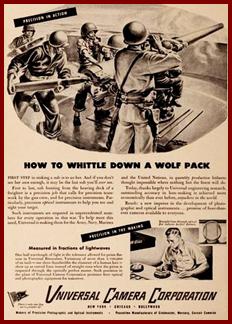
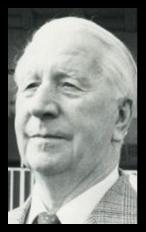
|
Leslie Evershed Martin |


|
(second example) Establts AFSA Serie 6 French Military binoculars MG/ Minist č re de la Guerre marked, but that are also UK military broad Arrow property Marked. |
|
My second pair of Establissments Afsa serie 6 binoculars carry the MG French Minist č re de la Guerre property mark, and they also carry the British Broad Arrow property mark. Presumably represents a Minist č re de la Guerre and UK ministry of defense coordinated equipment supply. |